Peugeot 301 2017 Owner's Manual
Manufacturer: PEUGEOT, Model Year: 2017, Model line: 301, Model: Peugeot 301 2017Pages: 306, PDF Size: 9.87 MB
Page 161 of 306
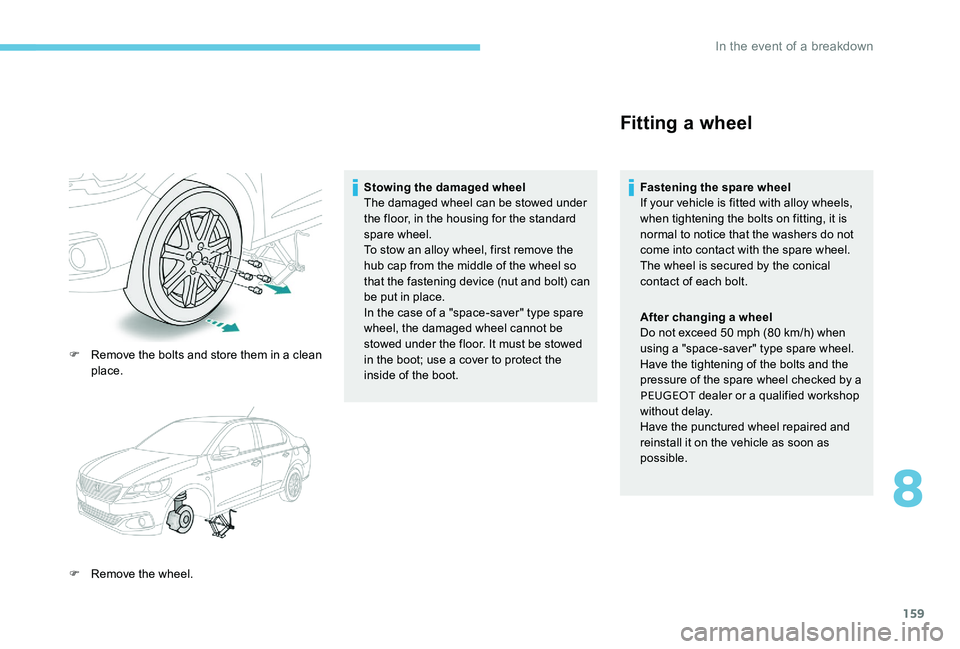
159
F Remove the bolts and store them in a clean place.
F
R
emove the wheel. Stowing the damaged wheel
The damaged wheel can be stowed under
the floor, in the housing for the standard
spare wheel.
To stow an alloy wheel, first remove the
hub cap from the middle of the wheel so
that the fastening device (nut and bolt) can
be put in place.
In the case of a "space-saver" type spare
wheel, the damaged wheel cannot be
stowed under the floor. It must be stowed
in the boot; use a cover to protect the
inside of the boot.
Fitting a wheel
Fastening the spare wheel
If your vehicle is fitted with alloy wheels,
when tightening the bolts on fitting, it is
normal to notice that the washers do not
come into contact with the spare wheel.
The wheel is secured by the conical
contact of each bolt.
After changing a wheel
Do not exceed 50 mph (80 km/h) when
using a "space-saver" type spare wheel.
Have the tightening of the bolts and the
pressure of the spare wheel checked by a
PEUGEOT
dealer or a qualified workshop
without delay.
Have the punctured wheel repaired and
reinstall it on the vehicle as soon as
possible.
8
In the event of a breakdown
Page 162 of 306
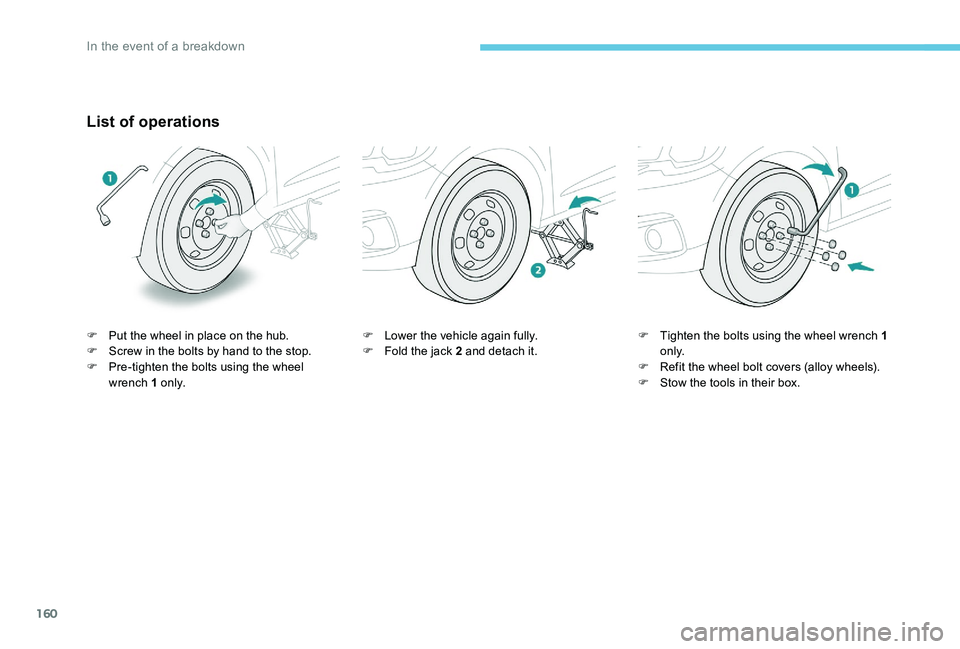
160
List of operations
F Put the wheel in place on the hub.
F S crew in the bolts by hand to the stop.
F
P
re-tighten the bolts using the wheel
wrench 1 o n l y. F
L ower the vehicle again fully.
F F old the jack 2 and detach it.F
T ighten the bolts using the wheel wrench 1
o n l y.
F
R
efit the wheel bolt covers (alloy wheels).
F
S
tow the tools in their box.
In the event of a breakdown
Page 163 of 306
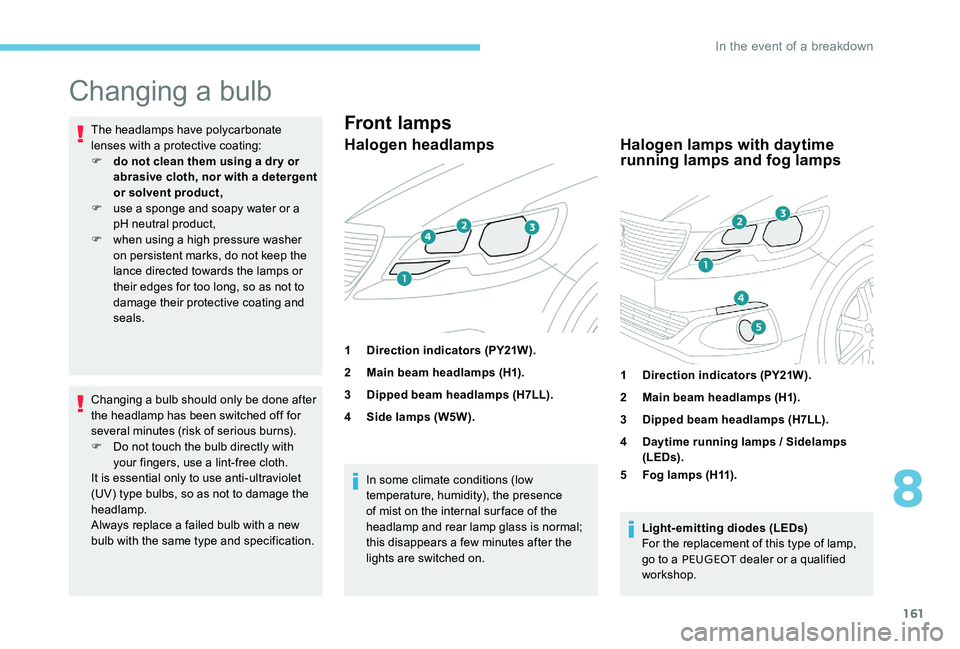
161
Changing a bulb
The headlamps have polycarbonate
lenses with a protective coating:
F
d
o not clean them using a dr y or
abrasive cloth, nor with a detergent
or solvent product,
F
u
se a sponge and soapy water or a
pH neutral product,
F
w
hen using a high pressure washer
on persistent marks, do not keep the
lance directed towards the lamps or
their edges for too long, so as not to
damage their protective coating and
seals.
Changing a bulb should only be done after
the headlamp has been switched off for
several minutes (risk of serious burns).
F
D
o not touch the bulb directly with
your fingers, use a lint-free cloth.
It is essential only to use anti-ultraviolet
(UV) type bulbs, so as not to damage the
headlamp.
Always replace a failed bulb with a new
bulb with the same type and specification. In some climate conditions (low
temperature, humidity), the presence
of mist on the internal sur face of the
headlamp and rear lamp glass is normal;
this disappears a few minutes after the
lights are switched on.Front lamps
Halogen headlamps
1
Direction indicators (PY21W).
2 Main beam headlamps (H1).
3 Dipped beam headlamps (H7LL).
4 Side lamps (W5W).
Halogen lamps with daytime
running lamps and fog lamps
1 Direction indicators (PY21W).
2 Main beam headlamps (H1).
3 Dipped beam headlamps (H7LL).
4 Daytime running lamps / Sidelamps (LEDs).
5 Fog lamps (H11).
Light-emitting diodes (LEDs)
For the replacement of this type of lamp,
go to a PEUGEOT dealer or a qualified
workshop.
8
In the event of a breakdown
Page 164 of 306
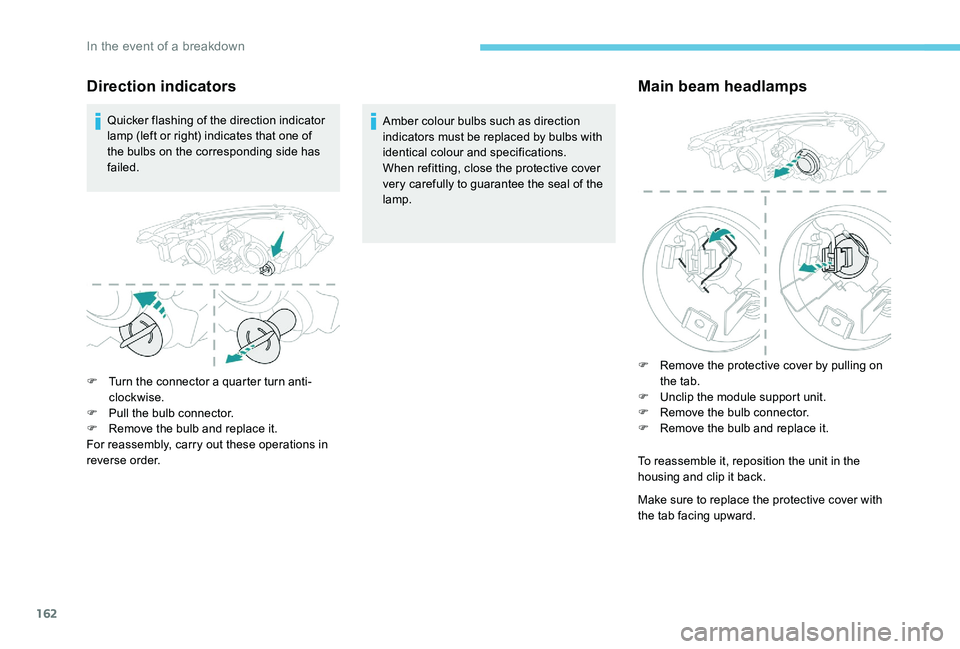
162
Direction indicators
Quicker flashing of the direction indicator
lamp (left or right) indicates that one of
the bulbs on the corresponding side has
failed.Amber colour bulbs such as direction
indicators must be replaced by bulbs with
identical colour and specifications.
When refitting, close the protective cover
very carefully to guarantee the seal of the
lamp.
F
T
urn the connector a quarter turn anti-
clockwise.
F
P
ull the bulb connector.
F
R
emove the bulb and replace it.
For reassembly, carry out these operations in
reverse order.
Main beam headlamps
F Remove the protective cover by pulling on the tab.
F
U
nclip the module support unit.
F
R
emove the bulb connector.
F
R
emove the bulb and replace it.
To reassemble it, reposition the unit in the
housing and clip it back.
Make sure to replace the protective cover with
the tab facing upward.
In the event of a breakdown
Page 165 of 306
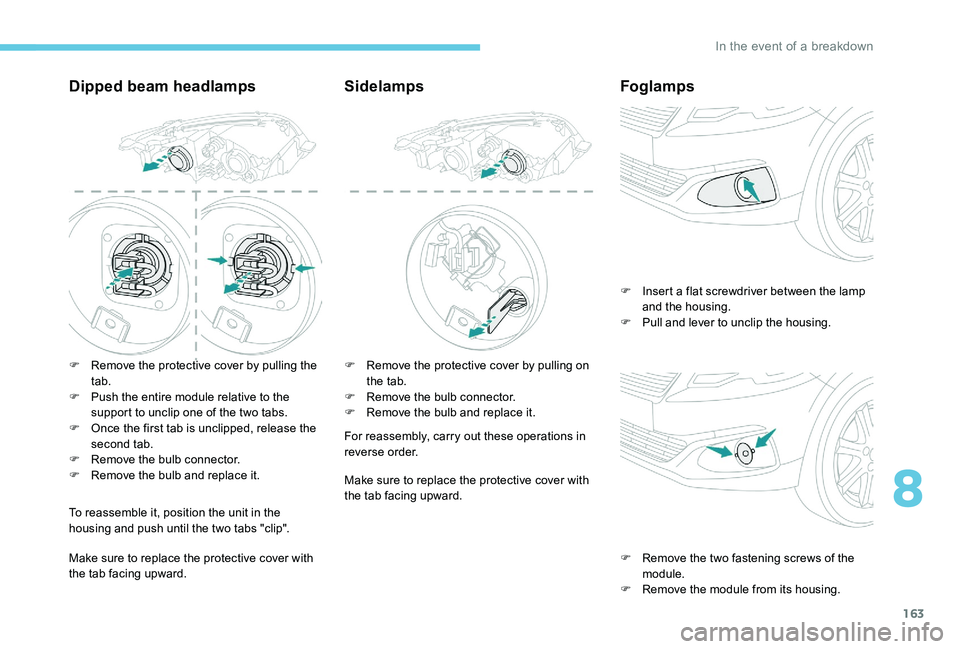
163
Dipped beam headlamps
F Remove the protective cover by pulling the tab.
F
P
ush the entire module relative to the
support to unclip one of the two tabs.
F
O
nce the first tab is unclipped, release the
second tab.
F
R
emove the bulb connector.
F
R
emove the bulb and replace it.
To reassemble it, position the unit in the
housing and push until the two tabs "clip".
Make sure to replace the protective cover with
the tab facing upward.
Sidelamps
F Remove the protective cover by pulling on the tab.
F
R
emove the bulb connector.
F
R
emove the bulb and replace it.
For reassembly, carry out these operations in
reverse order.
Make sure to replace the protective cover with
the tab facing upward.
Foglamps
F Insert a flat screwdriver between the lamp and the housing.
F
P
ull and lever to unclip the housing.
F
R
emove the two fastening screws of the
module.
F
R
emove the module from its housing.
8
In the event of a breakdown
Page 166 of 306
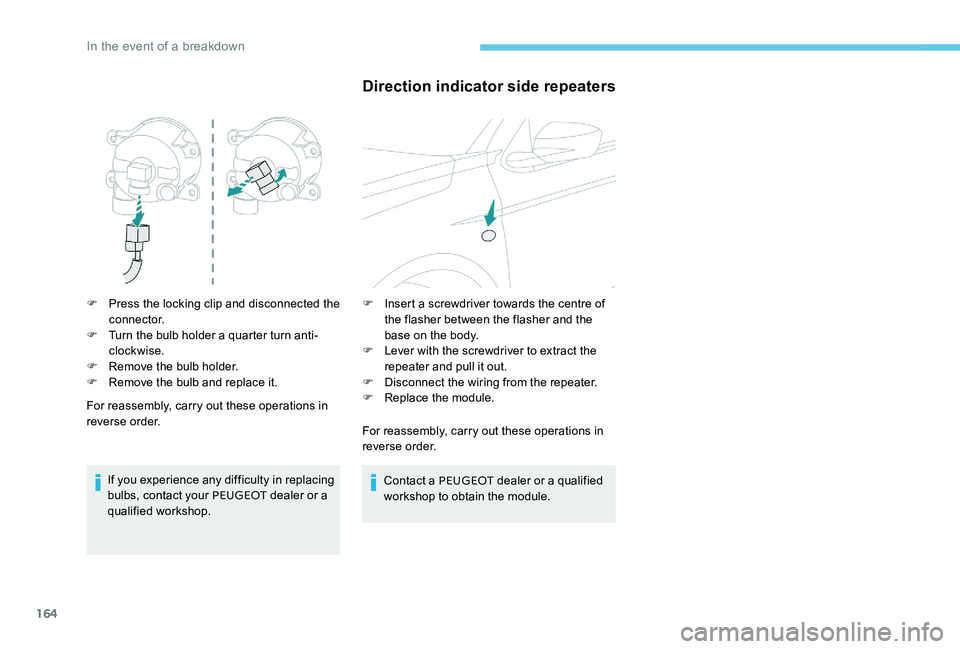
164
F Press the locking clip and disconnected the connector.
F
T
urn the bulb holder a quarter turn anti-
clockwise.
F
R
emove the bulb holder.
F
R
emove the bulb and replace it.
For reassembly, carry out these operations in
reverse order.
If you experience any difficulty in replacing
bulbs, contact your PEUGEOT dealer or a
qualified workshop.
Direction indicator side repeaters
F Insert a screwdriver towards the centre of the flasher between the flasher and the
base on the body.
F
L
ever with the screwdriver to extract the
repeater and pull it out.
F
D
isconnect the wiring from the repeater.
F
R
eplace the module.
For reassembly, carry out these operations in
reverse order.
Contact a PEUGEOT dealer or a qualified
workshop to obtain the module.
In the event of a breakdown
Page 167 of 306
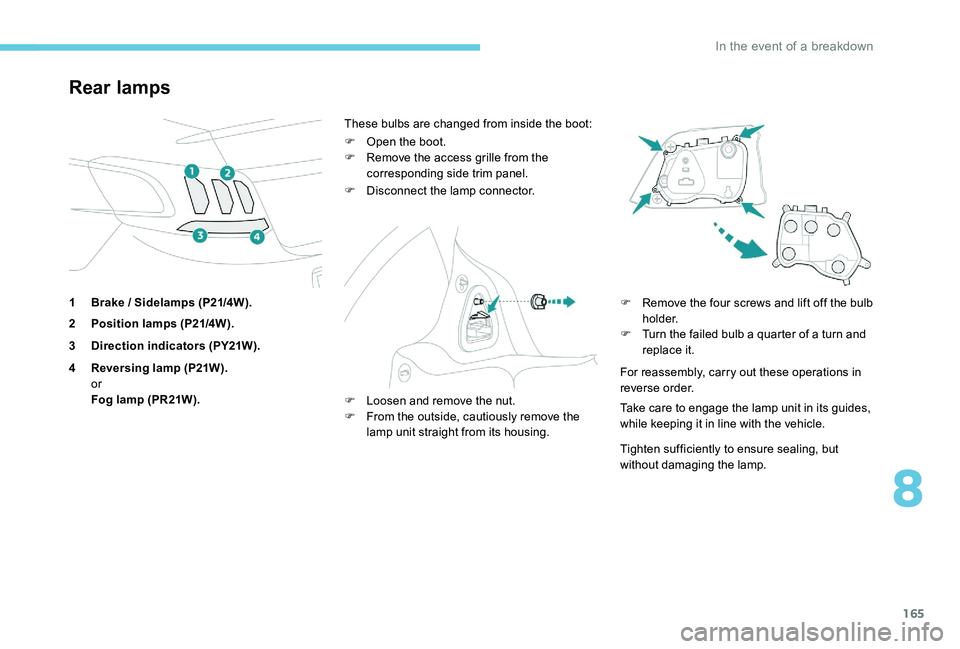
165
Rear lamps
1 Brake / Sidelamps (P21/4W).
2 Position lamps (P21/4W).
3Direction indicators (PY21W).
4 Reversing lamp (P21W). or
Fog lamp (PR21W). These bulbs are changed from inside the boot:
F
O
pen the boot.
F
R
emove the access grille from the
corresponding side trim panel.
F
D
isconnect the lamp connector.
F
L
oosen and remove the nut.
F
F
rom the outside, cautiously remove the
lamp unit straight from its housing. F
R emove the four screws and lift off the bulb
h o l d e r.
F
T
urn the failed bulb a quarter of a turn and
replace it.
For reassembly, carry out these operations in
reverse order.
Take care to engage the lamp unit in its guides,
while keeping it in line with the vehicle.
Tighten sufficiently to ensure sealing, but
without damaging the lamp.
8
In the event of a breakdown
Page 168 of 306
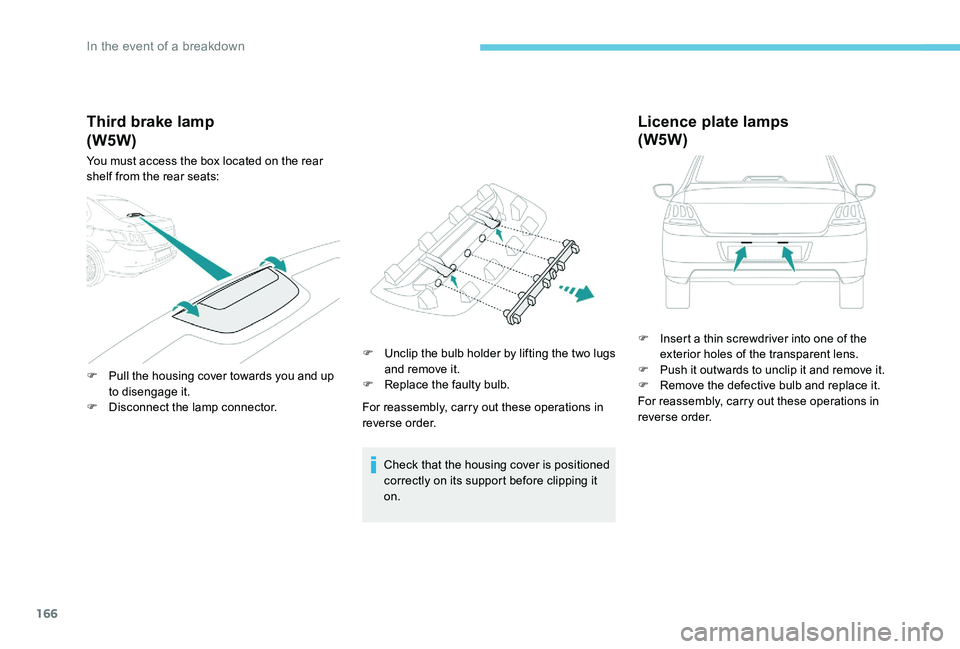
166
Third brake lamp
You must access the box located on the rear
shelf from the rear seats:
F
P
ull the housing cover towards you and up
to disengage it.
F
D
isconnect the lamp connector. F
U
nclip the bulb holder by lifting the two lugs
and remove it.
F
R
eplace the faulty bulb.
For reassembly, carry out these operations in
reverse order.
Check that the housing cover is positioned
correctly on its support before clipping it
on.
Licence plate lamps
(W5W)
F Insert a thin screwdriver into one of the exterior holes of the transparent lens.
F
P
ush it outwards to unclip it and remove it.
F
R
emove the defective bulb and replace it.
For reassembly, carry out these operations in
reverse order.
(W5W)
In the event of a breakdown
Page 169 of 306
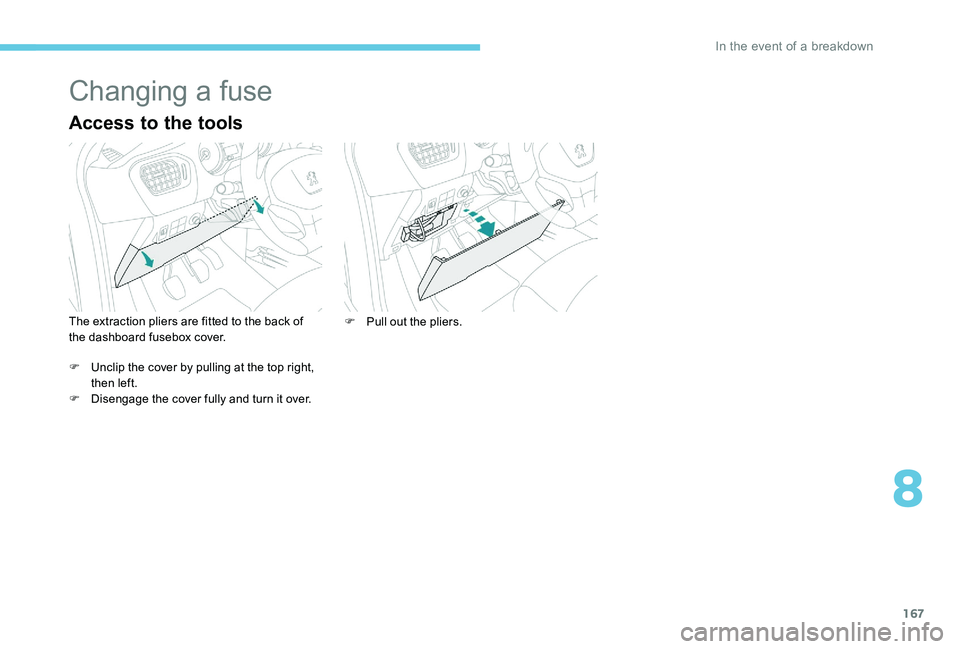
167
Changing a fuse
Access to the tools
The extraction pliers are fitted to the back of
the dashboard fusebox cover.
F
U
nclip the cover by pulling at the top right,
then left.
F
D
isengage the cover fully and turn it over. F
P ull out the pliers.
8
In the event of a breakdown
Page 170 of 306
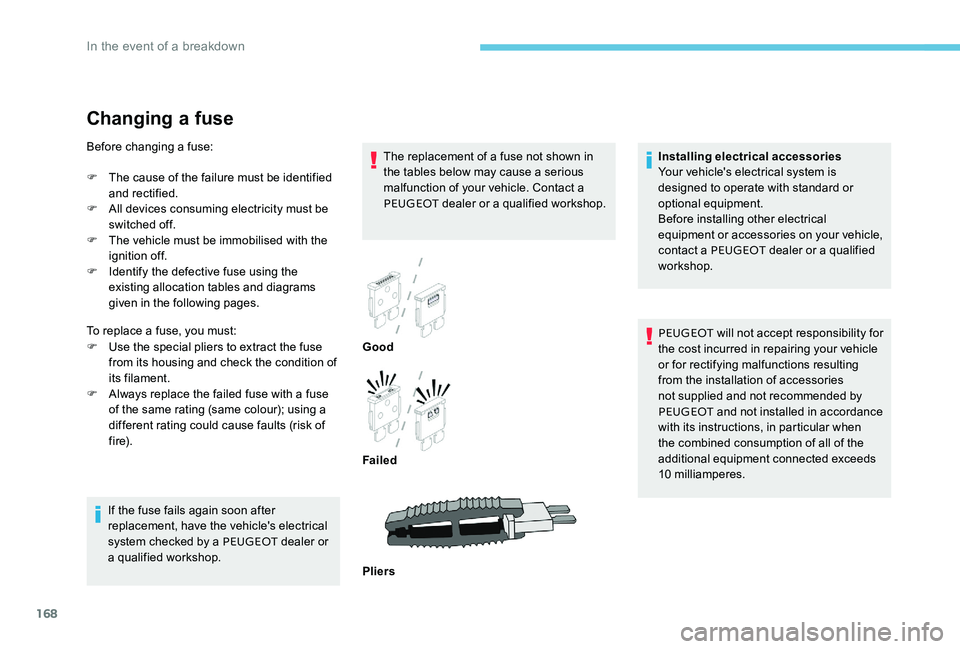
168
Changing a fuse
The replacement of a fuse not shown in
the tables below may cause a serious
malfunction of your vehicle. Contact a
PEUGEOT dealer or a qualified workshop.
If the fuse fails again soon after
replacement, have the vehicle's electrical
system checked by a PEUGEOT dealer or
a qualified workshop. Good
Failed
Pliers
Before changing a fuse:
F
T
he cause of the failure must be identified
and rectified.
F
A
ll devices consuming electricity must be
switched off.
F
T
he vehicle must be immobilised with the
ignition off.
F
I
dentify the defective fuse using the
existing allocation tables and diagrams
given in the following pages.
To replace a fuse, you must:
F
U
se the special pliers to extract the fuse
from its housing and check the condition of
its filament.
F
A
lways replace the failed fuse with a fuse
of the same rating (same colour); using a
different rating could cause faults (risk of
f i r e). Installing electrical accessories
Your vehicle's electrical system is
designed to operate with standard or
optional equipment.
Before installing other electrical
equipment or accessories on your vehicle,
contact a PEUGEOT
dealer or a qualified
workshop.
PEUGEOT will not accept responsibility for
the cost incurred in repairing your vehicle
or for rectifying malfunctions resulting
from the installation of accessories
not supplied and not recommended by
PEUGEOT and not installed in accordance
with its instructions, in particular when
the combined consumption of all of the
additional equipment connected exceeds
10 milliamperes.
In the event of a breakdown